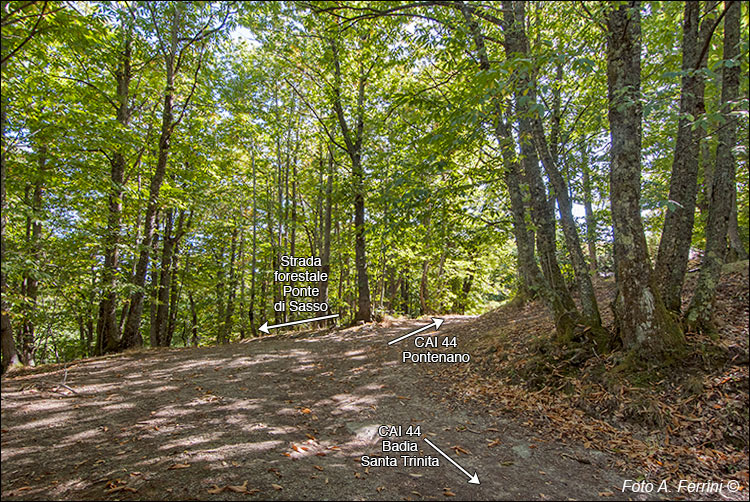Dal piccolo borgo di Capraia a Santa Trinita
Il sentiero da Capraia a Badia Santa Trinita e possibile ritorno su due percorsi diversi
Italiano
LUOGHI E PERCORSI NEI PRESSI DI BADIA SANTA TRINITA 50
Dopo un paio di chilometri da Badia Santa Trinita, seguendo il CAI 44 siamo giunti a Fonte Cavallari, località inconfondibile per la presenza di due case. Di fronte alla strada a destra che sale ad una casa, lasciamo il CAI 44, che prosegue per Pontenano, per imboccare, a sinistra, una pista forestale che per qualche decina di metri scende in modo abbastanza ripido.
Fonte Cavallari (930 metri di quota) fu un antico podere. Fino a metà Novecento vi erano cinque case, difficile dire a quando risalenti, in una mappa catastale del 1824 ne figurano due. In questo podere oltre alla consueta attività agricola si faceva altro, il toponimo ci dice già qualcosa. Intanto che c'è una fonte, ma non possiamo fruirne perché posta in un luogo ormai inaccessibile, poi, che c'era qualcosa legato ai cavalli. Infatti, una tradizione racconta che qui ci sia stato, in periodo imprecisato, un luogo dove ci si occupava di questi animali.
Più conosciuta è la storia di Fonte Cavallari nel XX secolo. Fino alla seconda guerra mondiale si coltivavano cereali, ma più che altro patate. Ci si occupava dei castagneti circostanti che dovevano fornire legna per il carbone, legname da opera, castagne per la farina e per sfamare i maiali. Fonte Cavallari la conobbe una storia particolare nella primavera estate del 1944. Divenne la base per una quarantina di partigiani, con loro stava una signora che si occupava dei servizi domestici. Ironia della sorte, si chiamava Italia. Dopo la guerra per Fonte Cavallari iniziò la fase di decadenza, rimase abitata stabilmente, da poche persone, solo per qualche anno.
After a couple of kilometers from Badia Santa Trinita, following the CAI 44 we reached Fonte Cavallari, an unmistakable location due to the presence of two houses. Here we leave the CAI 44 to take, on the left, a forest track which descends quite steeply for a few dozen metres.
Fonte Cavallari (930 meters above sea level) was an ancient farm. Until the mid-twentieth century there were five houses, it is difficult to say when they date back, but two of them appear in a cadastral map from 1824. On this farm, in addition to the usual agricultural activity, something else was done, the toponym already tells us something. First of all, there is a source, but we cannot use it because it is located in a place that is now inaccessible, then, there was something related to the horses. In fact, a tradition says that here there was, in an unspecified period, a place where these animals were cared for.
The history of Fonte Cavallari in the 20th century is better known. Until the Second World War, cereals were grown, but mostly potatoes. We took care of the surrounding chestnut groves which had to provide wood for coal, wood for construction, chestnuts for flour and to feed the pigs. Fonte Cavallari experienced a particular history in the spring and summer of 1944. It became the base for around forty partisans, with them was a lady who took care of domestic services. Ironically, her name was Italia. After the war, a phase of decline began for Fonte Cavallari and it remained permanently inhabited by a few people for only a few years.











































































































